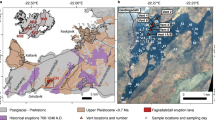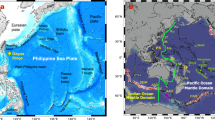Abstract
The relative importance of the degree of partial melting and of the composition of the source; is investigated for basalts of various origins on the basis of observed Th isotopic variations. If the oceanic island basalts (OIB) and the mid-oceanic ridge basalts (MORB) are not mutually contaminated, the Th isotopic tracers show that the difference between MORB and OIB is due to a difference in the composition of their sources rather than in the degree of partial melting. The characteristics of the island arc volcanics are completely different from those for the oceanic basalts, thereby implying a difference in both their origin and their geochemical process of petrogenesis.
This is a preview of subscription content, access via your institution
Access options
Subscribe to this journal
Receive 51 print issues and online access
$199.00 per year
only $3.90 per issue
Buy this article
- Purchase on Springer Link
- Instant access to full article PDF
Prices may be subject to local taxes which are calculated during checkout
Similar content being viewed by others
References
Yoder, H. S. Jr & Tilley, C. E. J. Petrol. 3, 342–532 (1962).
Yoder, H. S. Jr Generation of Basaltic Magma (National Academy of Sciences, Washington DC, 1976).
Condomines, M., Morand, P. & Allègre, C. J. Earth planet. Sci. Lett. 55, 247–256 (1981).
Tatsumoto, M. Earth planet. Sci. Lett. 38, 63–87 (1978).
Allègre, C. J., Brevart, O., Dupré, B. & Minister, J. F. Phil. Trans. R. Soc. A297, 447–477 (1980).
Dupré, B. & Allègre, C. J. Nature 286, 17–22 (1980).
Allègre, C. J. Earth planet. Sci. Lett. 5, 209–210 (1968).
Allègre, C. J. & Condomines, M. Earth planet. Sci. Lett. 28, 395–406 (1976).
Condomines, M., Morand, P., Allègre, C. J. & Sigvaldasson, G. Earth planet. Sci. Lett. 55, 393–406 (1981).
Condomines, M., Bernat, M. & Allègre, C. J. Earth planet. Sci. Lett. 33, 122–125 (1976).
Condomines, M., Tanguy, J. C., Kieffer, G. & Allègre, C. J. Geochim. cosmochim. Acta (in the press).
Morand, P., Condomines, M. & Allègre, C. J. C.r. Acad. hebd. Séanc. Sci., Paris 286 D, 1845 (1978).
Capaldi, G. et al. Bull. volcan. 41, 259–285 (1978).
Schilling, J. G. Nature 246, 141–143 (1973).
Tarney, J., Wood, D. A., Saunders, A. D., Cann, J. R. & Varet, J. Phil. Trans. R. Soc. 179–202 (1980).
Baranowski, J. & Harmon, R. S. 4th Int. Conf. Geochronol., Isotope Geol. Snow Mass, U.S.G. Open file 22–24 (1978).
Newman, S., Finkel, R. C. & MacDougall, J. D. EOS 62, 45, 1076 (1981).
Author information
Authors and Affiliations
Rights and permissions
About this article
Cite this article
Allègre, C., Condomines, M. Basalt genesis and mantle structure studied through Th-isotopic geochemistry. Nature 299, 21–24 (1982). https://doi.org/10.1038/299021a0
Received:
Accepted:
Published:
Issue Date:
DOI: https://doi.org/10.1038/299021a0
This article is cited by
-
Subducting serpentinites release reduced, not oxidized, aqueous fluids
Scientific Reports (2019)
-
Evidence from Sardinian basalt geochemistry for recycling of plume heads into the Earth's mantle
Nature (2000)
-
Melting of a subducting oceanic crust from U–Th disequilibria in austral Andean lavas
Nature (1998)
-
Magmatic evolution of Pacaya and Cerro Chiquito volcanological complex, Guatemala
Bulletin of Volcanology (1992)
-
Uranium and 10Be enrichments by fluids in Andean arc magmas
Nature (1990)
Comments
By submitting a comment you agree to abide by our Terms and Community Guidelines. If you find something abusive or that does not comply with our terms or guidelines please flag it as inappropriate.



